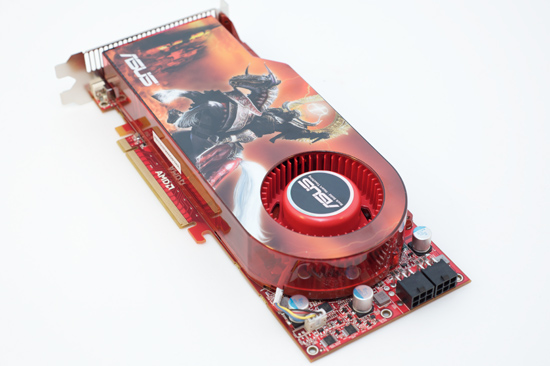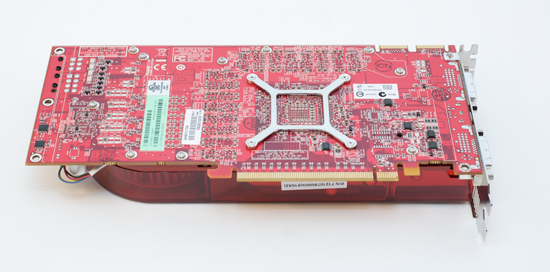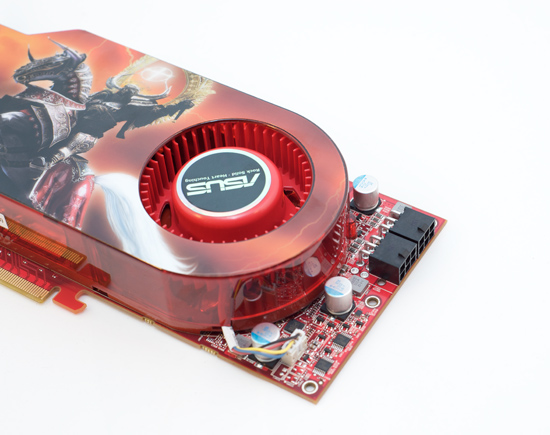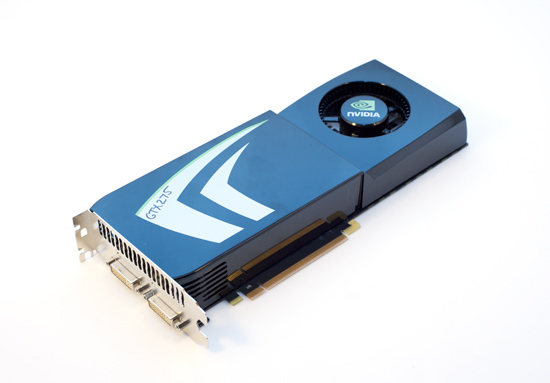ATI Radeon HD 4890 vs. NVIDIA GeForce GTX 275
by Anand Lal Shimpi & Derek Wilson on April 2, 2009 12:00 AM EST- Posted in
- GPUs
The Cards and The Test
In the AMD department, we received two cards. One was an overclocked part from HIS and the other was a stock clocked part from ASUS. Guess which one AMD sent us for the review. No, it's no problem, we're used to it. This is what happens when we get cards from NVIDIA all the time. They argue and argue for the inclusion of overclocked numbers in GPU reviews when it's their GPU we're looking at. Of course when the tables are turned so are the opinions. We sincerely appreciate ASUS sending us this card and we used it for our tests in this article. The original intent of trying to get a hold of two cards was to run CrossFire numbers, but we only have one GTX 275 and we would prefer to wait until we can compare the two to get into that angle.



The ASUS card also includes a utility called Voltage Tweaker that allows gamers to increase some voltages on their hardware to help improve overclocking. We didn't have the chance to play with the feature ourselves, but more control is always a nice feature to have.

For the Radeon HD 4890 our hardware specs are pretty simple. Take a 4870 1GB and overclock it. Crank the core up 100 MHz to 850 MHz and the memory clock up 75 MHz to 975 MHz. That's the Radeon HD 4890 in a nutshell. However, to reach these clock levels, AMD revised the core by adding decoupling capacitors, new timing algorithms, and altered the ASIC power distribution for enhanced operation. These slight changes increased the transistor count from 956M to 959M. Otherwise, the core features/specifications (texture units, ROPs, z/stencil) remain the same as the HD4850/HD4870 series.
Most vendors will also be selling overclocked variants that run the core at 900 MHz. AMD would like to treat these overclocked parts like they are a separate entity altogether. But we will continue to treat these parts as enhancements of the stock version whether they come from NVIDIA or AMD. In our eyes, the difference between, say, an XFX GTX 275 and an XFX GTX 275 XXX is XFX's call; the latter is their part enhancing the stock version. We aren't going to look at the XFX 4890 and the XFX 4890 XXX any differently. In doing reviews of vendor's cards, we'll consider overclocked performance closely, but for a GPU launch, we will be focusing on the baseline version of the card.
On the NVIDIA side, we received a reference version of the GTX 275. It looks similar to the design of the other GT200 based hardware.

Under the hood here is the same setup as half of a GTX 295 but with higher clock speeds. That means that the GTX 275 has the memory amount and bandwidth of the GTX 260 (448-bit wide bus), but the shader count of the GTX 280 (240 SPs). On top of that, the GTX 275 posts clock speeds closer to the GTX 285 than the GTX 280. Core clock is up 31 MHz from a GTX 280 to 633 MHz, shader clock is up 108 MHz to 1404 MHz, and memory clock is also up 108 MHz to 2322. Which means that in shader limited cases we should see performance closer to the GTX 285 and in bandwicth limited cases we'll still be faster than the GTX 216 because of the clock speed boost across the board.
Rather than just an overclock of a pre-existing card, this is a blending of two configurations combined with an overclock from the two configurations from which it was born. And sure, it's also half a GTX 295, and that is convenient for NVIDIA. It's not just that it's different, it's that this setup should have a lot to offer especially in games that aren't bandwidth limited.
That wraps it up for the cards we're focusing on today. Here's our test system, which is the same as for our GTS 250 article except for the addition of a couple drivers.
The Test
| Test Setup | |
| CPU | Intel Core i7-965 3.2GHz |
| Motherboard | ASUS Rampage II Extreme X58 |
| Video Cards | ATI Radeon HD 4890 ATI Radeon HD 4870 1GB ATI Radeon HD 4870 512MB ATI Radeon HD 4850 NVIDIA GeForce GTX 285 NVIDIA GeForce GTX 280 NVIDIA GeForce GTX 275 NVIDIA GeForce GTX 260 core 216 |
| Video Drivers | Catalyst 8.12 hotfix, 9.4 Beta for HD 4890 ForceWare 185.65 |
| Hard Drive | Intel X25-M 80GB SSD |
| RAM | 6 x 1GB DDR3-1066 7-7-7-20 |
| Operating System | Windows Vista Ultimate 64-bit SP1 |
| PSU | PC Power & Cooling Turbo Cool 1200W |










294 Comments
View All Comments
7Enigma - Thursday, April 2, 2009 - link
And just go and disregard everything I typed (minus the different driver versions). Xbit apparently underclocked the 4890 to stock speeds. So I have no clue how the heck their numbers are so significantly different, except they have this posted on system settings:ATI Catalyst:
Smoothvision HD: Anti-Aliasing: Use application settings/Box Filter
Catalyst A.I.: Standard
Mipmap Detail Level: High Quality
Wait for vertical refresh: Always Off
Enable Adaptive Anti-Aliasing: On/Quality
Other settings: default
Nvidia GeForce:
Texture filtering – Quality: High quality
Texture filtering – Trilinear optimization: Off
Texture filtering – Anisotropic sample optimization: Off
Vertical sync: Force off
Antialiasing - Gamma correction: On
Antialiasing - Transparency: Multisampling
Multi-display mixed-GPU acceleration: Multiple display performance mode
Set PhysX GPU acceleration: Enabled
Other settings: default
If those are set differently in Anand's review I'm sure you could get some weird results.
SiliconDoc - Monday, April 6, 2009 - link
LOL - set PhysX gpu accelleration enabled.roflmao
Yeah man, I'm gonna get me that red card... ( if you didn't detect sarcasm, forget it)
tamalero - Thursday, April 9, 2009 - link
good to know you blame everyone for "bad reading understanding"let's see
ATI Catalyst:
Smoothvision HD: Anti-Aliasing: Use application settings/Box Filter
Catalyst A.I.: Standard
Mipmap Detail Level: High Quality
Wait for vertical refresh: Always Off
Enable Adaptive Anti-Aliasing: On/Quality
Other settings: default
Nvidia GeForce:
Texture filtering – Quality: High quality
Texture filtering – Trilinear optimization: Off
you see the big "NVIDIA GEFORCE:" right below "other settings"?
that means the physX was ENABLED on the GEFORCE CARD.
you sir, are a nvidia fanboy and a big douché
SiliconDoc - Thursday, April 23, 2009 - link
More personal attacks, when YOU are the one who can't read, you IDIOT.Here are my first two lines: LOL - set PhysX gpu accelleration enabled.
roflmao
_____
Then you tell me it says PhySx is enabled - which is what I pointed out. You probably did not go see the linked test results at the other site, and put two and two together.
Look in the mirror and see who can't read, YOU FOOL.
Better luck next time crowing barnyard animal.
"Cluckle red 'el doo ! Cluckle red 'ell doo !"
Let's see, I say PhySx is enabled, and you scream at me to point out it says PhysX is enabled, and call me an nvidia fan because of it - which would make you an nvidia fan as well - according to you, IF you knew what the heck you were doing, which YOU DON'T.
That makes you - likely a red rooster... I may check on that - hopefully you're not a noob poster, too, as that would reduce my probabilities in the discovery phase. Good luck, you'll likely need it after what I've seen so far.
7Enigma - Thursday, April 2, 2009 - link
Looked even closer and the drivers used were different.ATI Drivers:
Anand-9.4 beta
Xbit-9.3
Nvidia:
Anand-185
Xbit-182.08
ancient46 - Thursday, April 2, 2009 - link
I don't see the fun in shooting cloth and unrealistic non impact resistant windows in high rise buildings. The video with the cloth was distracting, it made me wonder why it was there. What was its purpose? My senior eyes did not see much of an improvement in the videos in the CUDA application.SiliconDoc - Monday, April 6, 2009 - link
Maybe someday you'll lose you're raging red fanboy bias, brakdown entirely, toss out your life religion, and buy an nvidia card. At that point perhaps Mirror's Edge will come with it, and after digging it out of the trash can (second thoughts you had), you'll try it, and like anand, really like it - turn it off, notice what you've been missing, turn it back on, and enjoy. Then after all that, you can crow "meh".I suppose after that you can revert to red rooster raging fanboy - you'll have to have your best red bud rip you from your Mirror's Edge addiction, but that's ok, he's a red and will probably smack you for trying it out - and have a clean shot with ow absorbed you'll be.
Well, that should rap it up.
poohbear - Thursday, April 2, 2009 - link
are the driver issues for AMD that significant that it needs to be mentioned in a review article? im asking in all honesty as i dont know. Also, this close developer relationship nvidia has w/ developers. does that show up in any games to significantly give a performance edge for nvidia vid cards? is there an example game out there for this? thanks.7Enigma - Thursday, April 2, 2009 - link
Look no further than this article. :) Here's the quote:"The first thing about Warmonger is that it runs horribly slow on ATI hardware, even with GPU accelerated PhysX disabled. I’m guessing ATI’s developer relations team hasn’t done much to optimize the shaders for Radeon HD hardware. Go figure."
But ATI also has some relations with developers that show an unusually high advantage as well (Race Driver G.R.I.D. for example). All in all, as long as no one is cheating by disabling effects or screwing with draw distances, it only benefits the consumer for the games to be optimized. The more one side pushes for optimizations, the more the other side is forced, or risk losing the benchmark wars (which ultimately decides purchases for most people).
SkullOne - Thursday, April 2, 2009 - link
In the conclusion mentions Nvidia's partners releasing OC boards but nothing about AMD. There is already two versions of the XFX HD4890 on Newegg. One is 850 core and the other is 875 core.The HD4890 is geared to open that SKU of "OC" cards for AMD. People with stock cooling and stock voltage can already push the card to 950+MHz. On the ASUS card you boost voltage to the GPU which has allowed people to get over 1GHz on their GPU. As the card matures seeing 1GHz cores on stock cooling and voltage will become a reality.
It seems like these facts are being ignored.